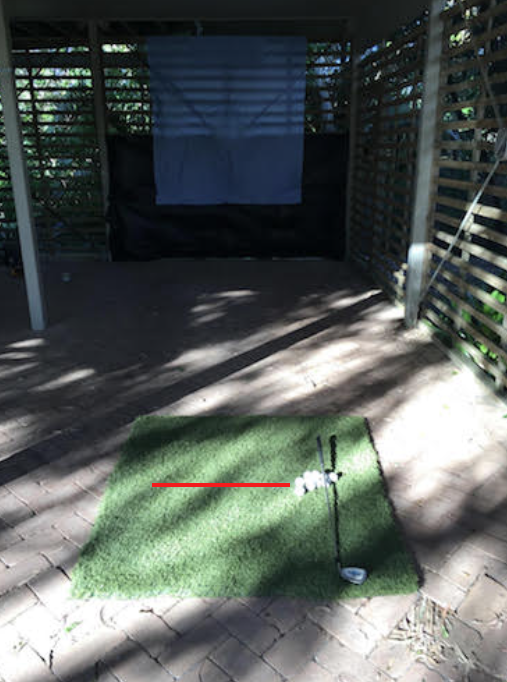Di is seeing me for some golf lessons over the next few weeks. Our first lesson went really well and it highlighted to me (for about the 897th time) that many golfers don’t know a really basic fundamental of the game. This is not to be critical of my students, but it’s a dig at the mainstream industry for ignoring this important principle.
And this is annoying, because if you don’t know this then you can’t play your best golf. And it’s funny, because we tend to get too caught up in grip theories, backswing plane and body pivot. But if you don’t get what I’m about to tell you, then all the swing theory stuff is next to useless. It just won’t help. What am I talking about here?
Check out the image below and then continue reading below:

Learning to strike the line and have the ball in the correct location is a key golf learning fundamental
See the red line? I added this to show you a hard-to-see chalk line that Di had drawn on the mat. What’s the chalk line for? Well it could be one of the most important training tools for any high handicap, beginning or struggling golfer. Here’s what it’s all about…
… during our first lesson, I drew a similar line on my teaching mat and asked Di the following question.
Cameron: Di, if the bottom of your club were to strike the line, where in relation to the line would the ball need to be situated? Would it be on the line, in front or behind?
Di suggested the ball would sit in front of the line. And this is what many inexperienced golfers say. They don’t understand that for this drill to be successful, the ball must be placed behind the line. You hit the ball first, and then the line. And if you’ve ever seen the divot pattern of a good golf shot, you’ll see this clearly. The divot starts in front of the ball.
But with many golfers thinking the exact opposite, it’s little wonder many struggle to make decent contact. In fact, it’s next to impossible to have any sort of consistent ball striking with this wrong outlook. And you can’t be consistent because you keep striking the ball “fat”. This means you’re hitting the ground first and not the ball. Once you start going down this path you’re forced to make all sorts of huge compensations just to hit the ball. You’re not working with your system and there’s all sorts of confusion. You just can’t play that well when you’re not whacking the golf ball first.
What’s most pleasing of all from my perspective is how Di has created a perfect little environment at home to practice her golf game. Get a mat, install a make shift net and get some Almost Golf Balls and you’re set. I’ve got no doubt that Di is going to make some significant gains over the next month or two. If nothing else, her ball striking will go to a new level and there’s going to be way less confusion. All this for a few minutes of practice a couple of times per week.
Go Di, go!

5 Comments
Adam
July 24, 2017I think ball spin is another fundamental lost to modern golf. Backspin makes the ball fly, and tilted backspin, or backspin with a small degree of sidespin, creates curvature. This is important for ball control, for example:
To keep the ball down underneath the wind, people put the ball back in their stance. This actually creates more backspin, in turn not allowing the ball to cut through the wind. If you take more club and swing easier, the spin is less, and you have a lower ball flight.
Controlling curve is also important, whether you fade or draw the ball. Aiming accordingly with a consistent fade or draw will make you more consistent, as well as allowing you to hit more fairways and greens. Im still trying to choose between the draw and the fade, which one I should consistently use. Since I’m a semi short hitter, I could use the draw for more power, but I could also use the fade to get more stopping power near the green. Straight shots are too hard to hit so I prefer to curve the ball hoth ways depending on the situation, but I’m torn on which one would best suit my game.
Still, ball spin, along with striking the ball first, are commonly missed fundamentals that seem to get no attention.
Ralph Hagelbarger
July 25, 2017Cameron this sounds something like Darrell Klassen preaches about ball control thru proper ball placement and use of the hands. Also uses power point focus approx 12-24 inches in front of the ball whether it’s wedge or driver- not on ball itself. Comments?
Leave A Response